
International Journal of Gynecology & Obstetrics, 21 June 2023 (Open access)
Objective
To determine how many times Ipas manual vacuum aspiration (MVA) instruments are reused, for what reasons, when the instruments are replaced and/or discarded, and what the barriers are to replacing them.
Methods
We conducted a mixed-methods cross-sectional study of health care providers who provide MVA services and key stakeholders in the supply chain to understand reuse and replacement of Ipas MVA aspirators and cannulae. Qualitative interviews focused on procurement and replacement of Ipas MVA instruments. The structured questionnaire was administered among MVA providers in Bolivia, Pakistan, India, Nigeria, Ghana, the Democratic Republic of the Congo (DRC), Ethiopia, Mozambique, and Kenya. It included questions about the reuse of the MVA instruments, providers’ role in reprocessing, decision-making around discarding and replacement, practices at their facility for using and reprocessing the instruments, and barriers to procuring new instruments.
Results
The authors interviewed 352 health care providers from nine countries from 2019 to 2021. Providers reported reusing MVA instruments an average of 34.4 times (standard deviation, 45). The reuse averages ranged from one time (Democratic Republic of the Congo) to 500 times (India), with figures varying between providers within the same country. Instrument malfunctioning rather than a specific number of uses drove reuse and subsequent replacement. The decision to replace was most commonly made by the provider during use. Half of the providers said that they knew of no issues with the supply chain, and 85% said they were always able to replace Ipas MVA instruments when needed.
Conclusion
Tracking reuse of MVA instruments was uncommon at participating providers’ health facilities. Providers’ estimates revealed great variability in reuse frequency and tracking procedures.
Authors: Elisabeth Eckersberger, Sally Dijkerman, Megan Perkins, True Overholt, Susana Asport, Hina Aziz, Ivania Barata, Sumit Gulati, Bekalu Mossie Chekol, Leonard Mulase, Jean-Claude Mulunda, Ayodeji Oginni, Marian Smith, Bill Powell, Nathalie Kapp



